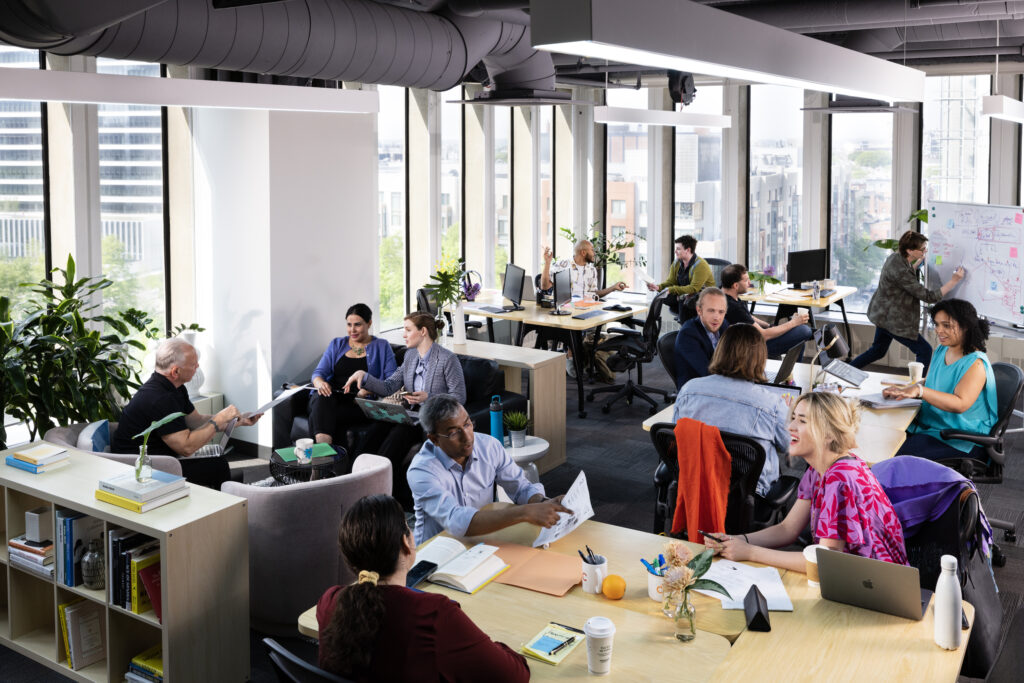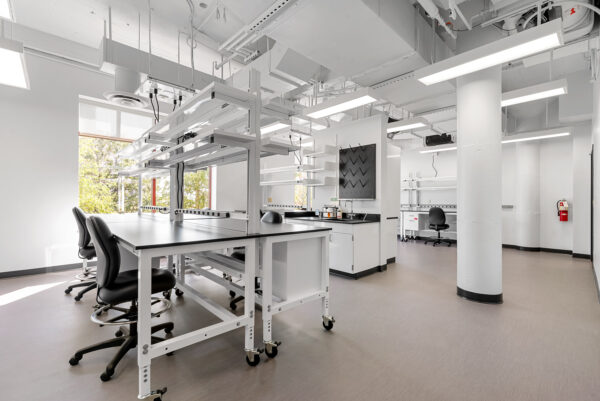Stacey Messier, General Manager, New England
Today’s million-dollar question on the minds of business leaders, employees, researchers, and everyone in between is: What does the future of work look like?
It’s something I often think about, too. I shared insights about the very topic on a panel about the future of work during the Academy of Management annual conference in 2023. As GM of New England for CIC, I see firsthand how the businesses in our innovation campuses tackle what work looks like today and how they plan for tomorrow.
I am a serial intrapreneur at heart. I’ve driven change and solved problems at organizations large and small throughout my career. Through that experience, I am confident that the future of work will not rely on one-size-fits-all approaches.
The key for strategic workspace decision-making today is a flexible approach that takes into consideration employee work styles, how the physical work environment is used, and how the organization is set up to roll with the punches in a continuously evolving business world.
Strategic workspace design must center around employees
The pandemic forced many businesses to hastily change the where and how of work to survive an uncertain time; not to mention the effects on ancillary businesses, like restaurants, coffee shops, and dry cleaners in neighborhoods that once relied on steady foot traffic from those working in these cities in person.
Current debates about “return to office” policies focus too heavily on employees’ physical location, causing friction between employers and employees. Some companies started tying promotions or other benefits to a particular number of in-person workdays.
It’s unlikely that return to office mandates that come off as arbitrary will achieve the desired effect. While there’s no secret formula for the “right” number of days to be physically at a workspace, there is one important factor that should create a new, collective culture your employees have been craving: clear communication about the purpose of in person work.
Companies that clearly outline how working in person aligns with company goals and expectations of teams will come out on top in the long term. Sharing with employees how their work activities and collaboration enable progress toward shared goals can uncover how best to spend their time – whether brainstorming in person or taking the space for asynchronous deep work when needed.
Clear expectations help align what is best for the company and the needs of employees. During a workshop I attended at Slalom in 2023, Dr. Upali Nanda shared the many ways workspaces should honor the needs of team members as their work styles and needs change throughout the day. It struck a chord with me because it echoed a resounding theme I see in action every day: flexibility in the workplace is about creating the space to accomplish team objectives and company goals.
Workspace design to encourage innovation is not a new concept. What is new is the shift from rigid workspace planning to an agile approach that intentionally designs and activates the physical space to support the needs and desired behaviors of employees.

How are companies strategically considering their workspace to center what matters to employees? When asked about the motivation for making workspace adjustments by Harvard Business Review Analytic Services (HBRAS), the top three reported motivations included improving culture and engagement, adjusting to remote/hybrid work, and encouraging employees to meet or work in person.
Small in-person interactions have a big impact at work
Visibility within the workplace matters for leaders, managers and individual contributors. Being in the room where work is happening allows for opportunities such as collaboration and mentorship.
It’s possible to achieve visibility in hybrid or remote settings, but one of the direct benefits of in person work is both seeing and being seen which can keep you on someone else’s radar more easily. Just as valuable are small in-person interactions throughout the day.
Dr. Jochen Menges and Dr. Lauren Howe, researchers at the University of Zurich Center for Leadership in the Future of Work, recently explored the impact of small relational interactions at work, like smiling at someone or laughing with them. Their study found that when leaders invested time in these interactions, it helped employees emotionally when faced with setbacks that caused frustration or anger.
For example, market conditions may mean that leadership needs to cancel a project that an employee spent considerable time and energy working on. The employee would understandably be disappointed or frustrated in that outcome. If the project leader made relational investments over time like saying good morning and sharing a joke with the employee, it would help lessen the emotional pain of the project’s cancellation.
Spending time together in the same room allows you to understand each other more holistically than through videoconferencing. The ability to build trust happens more authentically and deeper in person.
The benefit of these seemingly small interactions extends outside one organization’s physical and metaphorical walls, particularly in shared workspaces like CIC innovation campuses. Take the offshore wind cluster in Providence as an example – a community of companies and people passionate about improving our planet through renewable energy.
Communal spaces like kitchens and hallways offer an infinite number of interactions throughout any given day. Each represents a chance for the important positive relational investments described in Dr. Menges and Dr. Howe’s research.
Because the members of our CIC community are often working on innovation related to complex problems and the likelihood of encountering challenges or facing failure is high, the potential benefit of those small interpersonal moments is enormous. It may result in finding a new partner for that next big idea or making a personal connection that strengthens the community.

Takeaways about the future of work
Summing it all up: People are the heart of every company and thrive when they feel they are seen. Smart, strategic leaders align their business and workspace strategies to enable employees to connect, collaborate, and innovate.
To make the most out of your workspace, carefully consider how it honors the needs and preferences of your employees. Prioritizing small interactions with colleagues pays long term emotional dividends.
Every workplace is unique and the future of work is constantly in flux. One blog post is unlikely to answer every question or provide a solution for every challenge. We’re in this together, business leaders, and sharing what has worked for us may inspire others.
Is flexible, shared workspace right for you?
Flexible workspace, like the office and lab space offered by CIC, can meet diverse needs for businesses. In a hybrid world, these spaces can balance the need for physical gathering space for employees while enabling remote work. Some organizations have found success with establishing satellite offices, for example.
Learn more about the benefits of strategic workspace adjustments in the full Redefining the Workspace to Strategically Support Corporate Culture, Innovation, and Growth report.




